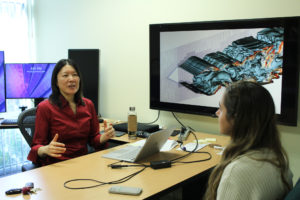
Xinfeng Gao, an associate professor in the Department of Mechanical Engineering, has recently been recognized with two awards for her research accomplishments in aerospace.
The first, the Mid-Career Advancement (MCA) award, comes from the National Science Foundation (NSF) and provides research funding to “scientists and engineers at the associate professor rank to substantively enhance and advance their research program through synergistic partnerships.”
The second award is the Outstanding Achievement Award for Women in Aerospace, given to Gao for her “success in transforming computational fluid dynamics with data assimilation to advance aerospace propulsion research while mentoring female students in aerospace.”
Engineering SOURCE recently sat down with Gao to learn more about her research and future goals.
What is your research focus?

My research focuses on computational fluid dynamics. As engineers, we think of air as a fluid, and I model and simulate the fluid dynamics of gas turbine engines used on aircraft. This is a difficult task because the physics of turbulence and combustion happen at small length and time scales. Consequently, the simulation must have a very fine resolution, beyond the capabilities of the nation’s most powerful computers, both now and in the foreseeable future. Engineers and scientists instead turn to modeling the complex physical interactions, versus directly solving them; however, this introduces uncertainty into the simulation. For a system as complex as a gas turbine engine, all those uncertainties add up, and the resulting simulation might no longer accurately represent a real engine. To improve predictability, I’ve dedicated my time to developing new ways to integrate computational fluid dynamics with data during the past decade. I pioneered the application of data assimilation methods from weather forecasting to combustion engineering and the development of new data assimilation methods to better accommodate the dynamics of turbulent combustion in complex reactive flows. Now, ten years later, the technology has shown tremendous potential, and these awards provide recognition that my research is an influential force in the aerospace industry.
How do you feel having won these awards? What are your dreams/goals going forward?
I am extremely honored to receive these prestigious awards, and I am earnestly grateful for the recognition from the National Science Foundation and the Women in Aerospace Organization. Embarking on a new path and continuing the journey can be lonely and taxing. Stamina, inspiration, and support are necessary. I have fortunately received them from my mentors, colleagues, and friends. Without them, winning these awards would not have been possible.
Going forward, I would like to grow my research and the CFD & Propulsion Laboratory to a new level by scaling up to an internationally known center, partnering with CFD software companies to introduce the new algorithms into practical software, and supporting nationwide aerospace initiatives.
You were awarded the Outstanding Achievement Award for Women in Aerospace not only for your research efforts but also because you mentor women interested in joining the aerospace industry. Tell us a little bit about your experience as a mentor.
Over the past decade or so, the number of women in aerospace has remained fairly stable, hovering around 11 percent. I find that women are often intimidated by this statistic, even the highly motivated ones. For example, Taylor Morton was one of my mentees just a few years ago. Taylor was extremely self-motivated and hoped to have an aerospace career but was a bit intimidated by the industry. During my mentorship, Taylor became a great undergraduate researcher in my lab, led the American Institute of Aeronautics and Astronautics (AIAA) CSU chapter president, and then pursued a graduate degree after completing her studies at CSU.
We also had an opportunity to talk with Morton. She credits Gao’s mentorship for landing her a spot in a top graduate program and a series of aerospace jobs working on lunar landers. Recently, she just accepted her dream job at Lockheed Martin working on their first-ever Mars sample return mission.
“The most valuable lesson I learned from her was to push myself to follow my dream career path,” Morton said. “She constantly encouraged me and demonstrated with her own successes that women can not only provide major contributions to the aerospace field but lead in it, as well.”